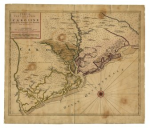HENDERSON WALKER
Governor: 1699-1703
by Dennis F. Daniels
Research Branch, NC Office of Archives and History, 2006.
https://www.dncr.nc.gov/about-us/history/division-historical-resources/nc-highway-historical-marker-program
See also: Henderson Walker, Dictionary of North Carolina Biography
 Henderson Walker (ca. 1659-1704), during “whose administration ye province injoyed that tranquility which is to be wished it may never want,” worked to establish the Church of England as a government supported religious denomination in North Carolina. Walker was born around 1659 and trained in the law. He arrived in Albemarle around 1682. In April 1686 Walker married Deborah Green; they had only one child, a daughter Elizabeth. In February 1694 Walker married Ann Lillington, daughter of Alexander and Elizabeth Lillington. The second marriage produced no children.
Henderson Walker (ca. 1659-1704), during “whose administration ye province injoyed that tranquility which is to be wished it may never want,” worked to establish the Church of England as a government supported religious denomination in North Carolina. Walker was born around 1659 and trained in the law. He arrived in Albemarle around 1682. In April 1686 Walker married Deborah Green; they had only one child, a daughter Elizabeth. In February 1694 Walker married Ann Lillington, daughter of Alexander and Elizabeth Lillington. The second marriage produced no children.
In Albemarle Walker led the life of a colonial gentleman. He acquired land, raised and sold livestock, and co-owned the sloop Debertus with a Boston merchant. Throughout his life, Walker worked as an attorney. He started out his public career as a clerk of the county courts. Walker held a variety of public offices, including assembly man and customs collector. He became attorney general in October 1695, a position he held briefly, and sat as a justice on the General Court, Court of Chancery, and Admiralty Court. He first joined the colonial council under Governor Thomas Harvey in 1694. As a council member, Walker was appointed as boundary commissioner by Governor Harvey in March 1699 to help settle the boundary dispute with Virginia. Following the death of Harvey in July 1699, Harvey was chosen by the council to serve as chief executive.
During Walker’s tenure, North Carolina enjoyed a period of relative peace and growth as people came from Virginia. However, Walker faced his share of problems. Cases were heard in court involving assaults upon colonists by Indians. In 1703, the Meherrin Indians were charged with “destroying their stock and burning their timber and houses refusing to pay tribute or render obedience to the Government.” Walker’s greatest challenge came from dealing with the royal and Virginia governments. The Crown wanted to gain control of the proprietary colonies in America. It used navigational acts and admiralty courts to undermine the proprietary colonies. Walker was caught between obeying the Crown or the Lords Proprietors. The Virginia government was worried about the large migration of settlers from Virginia to North Carolina and the two colonies continued to debate the unsettled boundary.
As a devoted Anglican, Walker worked to make the Church of England stronger in North Carolina. In November 1701, a receptive assembly enacted the first law (known as a vestry act) that established parishes and vestries and provided “for building of Churches and establishing a maintenance for Ministers.” A poll tax “on every Tythable in the precinct” was evidently the way the Church of England was to support itself. This act was not popular with non-Anglicans.
Walker continued as governor until summer 1703 when he relinquished the governorship to Robert Daniel. Walker remained on the council, serving as its president from 1703 to 1704 and continued to sit as a justice. Walker died on April 14, 1704 and was buried at his plantation “on a point of land not far from the water [Albemarle Sound], and sufficiently elevated above it to command an extensive prospect in every direction.” However, the encroachment of the water in time resulted in the governor’s remains being moved to the churchyard of St. Paul’s Episcopal Church in Edenton.
References:
Cain, Robert J. 1984. Records of the executive council. Colonial records of North Carolina, v. 7-8. Raleigh, N.C.: Dept. of Cultural Resources, Division of Archives and History.
Cain, Robert J., and Dennis Isenbarger. 1999. The Church of England in North Carolina: documents, 1699-1741. The colonial records of North Carolina, v. 10. Raleigh: Division of Archives and History, North Carolina Dept. of Cultural Resources.
Crayon, Porte. 1857. North Carolina illustrated. Harper’s New Monthly Magazine. 14: 449.
Hathaway, J. R. B., ed. 1903. Births, Deaths and Marriages in Berkely, Later Perquimans Precinct, N.C. North Carolina historical and genealogical record. 3 (April): 199-220. https://catalog.hathitrust.org/api/volumes/oclc/4168259.html
Hathaway, J. R. B., ed. 1903. Henderson Walker to the Court. North Carolina historical and genealogical record. 3 (January): 137-138. https://catalog.hathitrust.org/api/volumes/oclc/4168259.html
Hathaway, J. R. B., ed. 1900. Letter from John Lawson to Gov. Walker, relating to the Bay River Indians. North Carolina historical and genealogical record. 1 (October): 598. https://catalog.hathitrust.org/api/volumes/oclc/4168259.html
Marley, Branson. 1942. Minutes of the General Court of Albemarle, 1684. North Carolina historical review. 19 (1): 48-58.
Parker, Mattie Erma Edwards. 1971. North Carolina higher-court records, 1697-1701. Raleigh, N.C.: State Dept. of Archives and History.
Parker, Mattie Erma Edwards, William S. Price, and Robert J. Cain. 1968. North Carolina higher-court records. The Colonial records of North Carolina, v. [2]-. Raleigh, N.C.: State Dept. of Archives and History.
Powell, William Stevens. 1991. Dictionary of North Carolina biography. Vol. 6, T-Z. Chapel Hill: University of North Carolina Press.
Price, William S., Ruth Clow Langston, and Donna Holmes Goswick. 1974. North Carolina higher-court records, 1702-1708. The Colonial records of North Carolina : second series, v. 4. Raleigh: Dept. of Cultural Resources, Division of Archives and History.
Raimo, John. 1980. Biographical directory of American colonial and Revolutionary governors, 1607-1789. Westport, Ct: Meckler Books.
University of North Carolina at Chapel Hill. 2008. Colonial and state records of North Carolina. Vol. 1. [Chapel Hill, N.C.]: University Library, UNC-Chapel Hill. https://docsouth.unc.edu/csr/
Image Credits:
Nicolas Sanson, Carte Particuliere de la Caroline, ca. 1696. ID: MC.150.1696sa;MARS Id:3.3.1.1.84. North Carolina Maps. https://dc.lib.unc.edu/cdm/ref/collection/ncmaps/id/113.
19 October 2006 | Daniels, Dennis F.